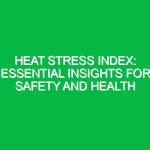Understanding Heat Stress Safety in the HSE Context
Heat stress Safety is an essential aspect of health, safety, and Environment (HSE) management, particularly in industries where workers are exposed to high temperatures. Heat stress occurs when the body cannot maintain its normal temperature due to excessive heat exposure, leading to various health issues ranging from heat exhaustion to heat stroke. In an age where climate change is increasing the frequency and severity of heat waves, ensuring the safety of workers in hot environments is more critical than ever.
In this article, we will explore the various dimensions of heat stress safety. We will delve into the causes and Effects of heat stress, the importance of implementing safety protocols, and practical tips to protect your workforce from heat-related illnesses.
The Science Behind Heat Stress
To effectively manage heat stress safety, it’s vital to understand how heat affects the human body. When exposed to high temperatures, the body attempts to cool itself through perspiration. However, this mechanism can become overwhelmed in extreme conditions, leading to an increase in core body temperature.
This can result in several heat-related illnesses, including:
- Heat Cramps: Painful muscle contractions that occur due to loss of electrolytes.
- Heat Exhaustion: Symptoms include heavy sweating, weakness, dizziness, nausea, and headache.
- Heat Stroke: A severe medical emergency characterized by a body temperature exceeding 104°F (40°C), confusion, seizures, and loss of consciousness.
Understanding these conditions is crucial for developing effective heat stress safety protocols.
Identifying Risks and Hazards
In the realm of heat stress safety, identifying potential Hazards is the first step in mitigating risks. Factors that contribute to heat stress include:
- Environmental Conditions: High ambient temperatures, humidity, and direct sunlight can significantly increase heat stress risk.
- Workplace Activity: High-intensity tasks or prolonged exertion can elevate body temperatures quickly.
- Personal Factors: Individual health issues, medications, and acclimatization levels play a role in how workers respond to heat.
By recognizing these factors, organizations can create a comprehensive heat stress safety plan tailored to their specific environment.
Best Practices for Heat Stress Safety
Creating a culture of heat stress safety involves implementing Best Practices that protect workers. Here are some actionable tips:
1. Monitor Environmental Conditions
Utilizing heat stress indices, such as the Wet Bulb Globe Temperature (WBGT), helps assess the risk of heat stress in real-time. Employers should regularly monitor these conditions and adjust work schedules accordingly.
2. Provide Adequate Hydration
Ensure that workers have access to cool water and encourage regular hydration breaks. A general guideline is to drink about 1 cup (8 ounces) of water every 15-20 minutes when working in the heat.
3. Schedule Breaks and Implement Work Rest Cycles
Employers should implement work-rest cycles that allow workers to take regular breaks in cooler areas. A common practice is to work for 50 minutes and rest for 10 minutes, especially during peak heat periods.
4. Educate Workers on Heat Stress
Training sessions that educate workers about the symptoms of heat stress and the importance of hydration can empower them to take necessary Precautions. Awareness is key to Prevention.
5. Use Personal Protective Equipment (PPE)
In some environments, PPE can contribute to heat stress. Consider using lighter materials or cooling vests to help regulate body temperature without compromising safety.
6. Acclimatization Programs
Introduce acclimatization programs for new workers or those returning after a long absence. Gradually increasing exposure to hot conditions can help the body adjust and minimize the risk of heat stress.
Real-Life Examples of Heat Stress Management
Consider the case of a construction company in Arizona that faced numerous heat-related incidents during summer months. After a thorough analysis, the management decided to implement a comprehensive heat stress safety program. This included regular hydration reminders, scheduled breaks, and an acclimatization process for new hires.
After six months, the company reported a 50% decrease in heat-related incidents. Workers also reported feeling more comfortable and productive, demonstrating the positive impact of a proactive approach to heat stress safety.
Regulations and Standards Governing Heat Stress Safety
Various Regulations exist to protect workers from heat-related illnesses. In the United States, the Occupational Safety and Health Administration (OSHA) provides guidelines for heat stress safety. While osha does not have a specific standard for heat stress, they recognize it as a serious workplace hazard and encourage employers to implement Heat Illness Prevention programs.
Employers must comply with general duty clauses that require them to provide a workplace free from recognized hazards. This includes taking steps to prevent heat stress. Other countries, such as those in the European Union, have specific regulations aimed at protecting workers from heat exposure, emphasizing the need for risk assessments and preventive measures.
Important Considerations for Compliance
To maintain compliance with heat stress safety regulations, employers should:
- Conduct regular risk assessments to identify potential hazards.
- Document Training programs on heat stress awareness.
- Keep records of heat-related incidents and response measures taken.
- Review and update heat stress safety policies regularly based on emerging research and Best Practices.
Conclusion: The Imperative of Heat Stress Safety
Heat stress safety is not just a regulatory requirement; it is a moral obligation to protect workers from potentially life-threatening conditions. By understanding the risks, implementing effective safety practices, and fostering a culture of awareness, employers can significantly reduce the incidence of heat-related illnesses.
As climate change continues to challenge traditional safety protocols, organizations must remain vigilant and proactive in their approach to heat stress safety. Ensuring that your workforce is protected not only promotes health and wellbeing but also enhances productivity and morale in the workplace.
In the end, the commitment to heat stress safety reflects a broader commitment to health, safety, and environmental Sustainability. Let us take the necessary steps today to secure a safer tomorrow for our workforce.


